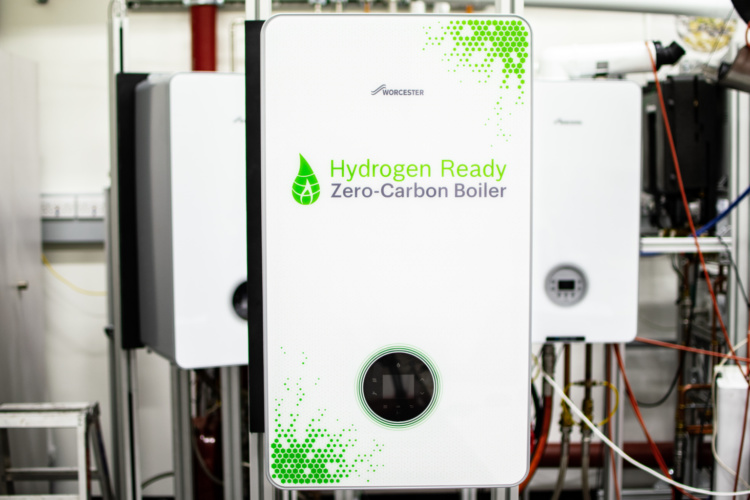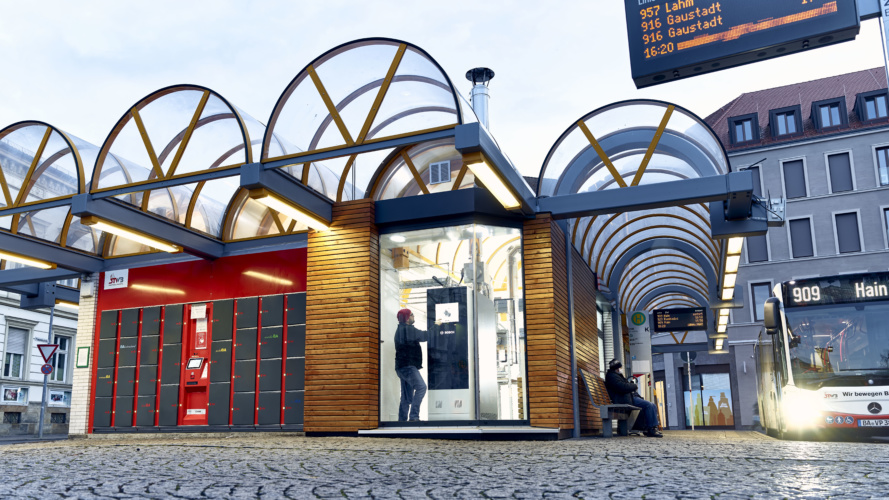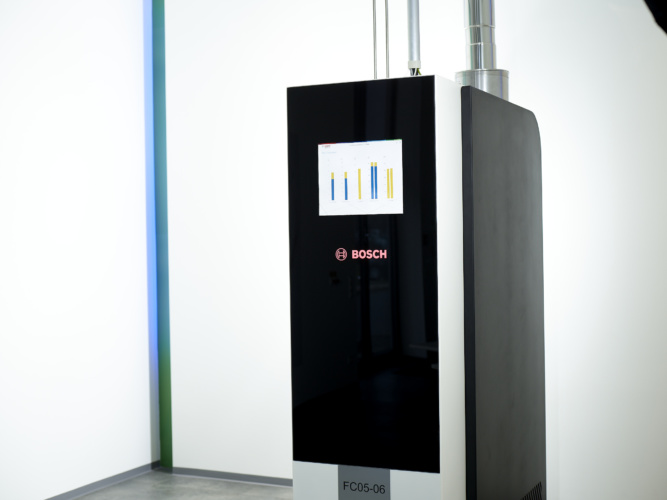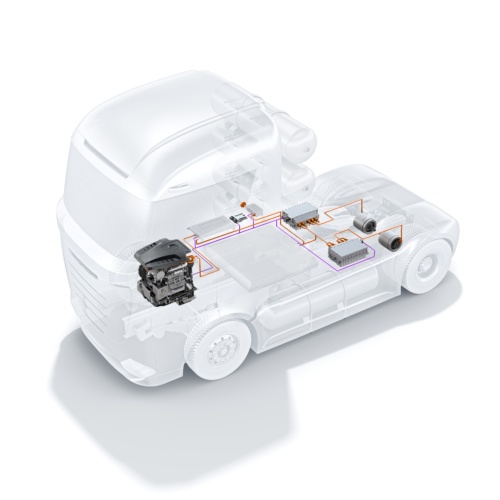Hydrogen as a green fuel source has long been considered a promising alternative to burning fossil fuels, but so far it has seen limited uptake. However, that appears to be changing with various companies around the world trialling multiple technologies across sectors from domestic heating to mobility – not just cars, but trains, ships and even aircraft.
Research by technology company Bosch has identified hydrogen as a megatrend and suggests the market for green hydrogen in the EU will be worth almost €40 billion (£33.73 billion) by 2030, with annual growth rates of 65 per cent.
Residential
Experts say the current rising gas prices could trigger the adoption of more green energy habits in the UK, with interest in hydrogen increasing.
A survey conducted by Bosch reveals that a third of those that took part would like to see hydrogen adopted as a mainstream fuel by 2030. As more people strive to be green, a third also said they would be willing to pay an extra £94 a month on average to use green energy such as hydrogen rather than natural gas. Furthermore, 42 per cent say that using hydrogen could be the answer to future fuel crises.

(Credit: Bosch)
However, whilst the demand to be green is evident, the research also shows that not enough is known about the benefits of using hydrogen or the UK’s strategy for adopting it. In fact, half of those surveyed said they didn't know if it was a clean energy. Further, two-thirds were unsure if the UK had a strategy to implement hydrogen as a mainstream fuel.
Vonjy Rajakoba, managing director of Bosch UK, said: “This is an exciting time for us in the UK and further afield. While hydrogen plays a substantial role in the decarbonisation plan laid out by the UK government, consumers are waking up to the positive impact that hydrogen power can have on the environment and our day-to-day lives. We truly hope that alternative fuels such as this will be high on the agenda at COP26 in Glasgow this month.”
Fuel cells convert hydrogen into electricity, and Bosch is developing both stationary and mobile fuel-cell solutions. From 2021 to 2024, Bosch plans to invest €1 billion (£850 million) in fuel-cell technology and estimates that the market for mobile fuel-cell components will be worth around €18 billion (£15.37 billion) by the end of the decade.
Dr Volkmar Denner, the chairman of the board of management of Robert Bosch GmbH, says the company “is already H2-ready and has what it takes to be a leader in this market”. The company’s plan is to put 100 stationary fuel-cell plants into operation this year. They will supply electricity to users such as data centres, industrial manufacturers, and residential areas.
Carl Arntzen, CEO of Worcester Bosch, agrees: “We already have a hydrogen-ready boiler for household central heating, developed here in the UK. We are meeting with government representatives and other businesses to offer a glimpse into what hydrogen can do.”
For the heating and hot water industry, removing carbon entirely is a complex matter, largely because of the existing infrastructure where the majority of UK homes rely on natural gas. However, Arntzen adds, with a third of UK greenhouse gases coming from our homes, it is clear that the UK will not meet its climate change targets without a revolution in home heating technology and fuel.
He continues: “Replacing natural gas boilers with hydrogen gas may be the simplest solution to the nation’s heating problems. The only by-product of using hydrogen is water, meaning that it is a carbon-free fuel source and could be a key method to help decarbonise heating and hot water in UK homes.”
Stationary fuel cells
Bosch installed a stationary solid-oxide fuel cell (SOFC) at the central bus station (ZOB) in Bamberg, Germany, at the end of March 2021 in partnership with the city’s public utilities company Stadtwerke Bamberg.

The refrigerator-sized plant generates around 10 kilowatts of electricity, with an overall efficiency of 60 per cent for power generation. This is enough to meet the annual requirements of more than 20 four-person households in the vicinity of the ZOB. The heat produced by the cell is used by a bakery at the ZOB for its heating and hot water systems. Utilising waste heat in this way increases the SOFCs efficiency to 85 per cent.
Dr Wilfried Kölscheid, who is responsible for stationary fuel cells at Bosch, says: “As we move to alternative forms of energy, decentralised power supplies are becoming very important. The stationary fuel cell is ideally suited for the expansion of local power and heating networks in urban neighbourhoods.”
Dr Michael Fiedeldey, managing director of Stadtwerke Bamberg, adds: “The experience we gain with this fuel cell should deliver lasting benefits when it comes to future energy supplies to existing buildings and new neighbourhoods.”
“At the same time, we want everyone to be able to experience the new technology for themselves. That’s why we didn’t hide it away in some basement, but instead installed it in the middle of the ZOB, which is a traffic hub visited by over 20,000 people a day.”
Once COVID restrictions are lifted, an ‘InnoLab’ at the ZOB will be open for interested guests to visit, with experts from both companies on hand to answer their questions.
The SOFC plant is currently running on natural gas, but it is suitable for hydrogen. When compared with the German electricity mix, an SOFC system reduces CO2 emissions by almost 40 per cent, even when running on natural gas. With the fuel cell running on hydrogen, it will no longer cause any direct CO2 emissions.

The SOFC’s output can be set to match demand, meaning it can ensure a sustainable supply of energy to cities and conurbations with high energy requirements. What’s more, connecting a series of fuel cells to the existing gas infrastructure is a way to relieve the power grid, meaning additional electricity demand can be met using on-site generation.
The SOFC plant in Bamberg is connected via 20 sensors to the Bosch IoT Cloud, continuously providing data on power generation and operating status and helping to further develop the technology. In future, Bosch says it will be possible to connect multiple SOFCs via the cloud to form virtual power plants and control them digitally using intelligent, self-learning software – conserving both the environment and resources.
Mobility
Bosch has also recently entered into a joint venture with China’s Qingling Motor Group, establishing Bosch Hydrogen Powertrain Systems (Chongqing) Co. Ltd, which aims to produce fuel-cell powertrains for all Chinese vehicle manufacturers. A fleet of 70 trucks is set to be trialled on the roads before the end of 2021 and launched commercially in the next 18 months.

“China is the most important growth market for electromobility,” says Stefan Hartung, Bosch board of management member and chairman of the Mobility Solutions business sector. “Especially for large, heavy vehicles that travel long distances, the fuel cell offers clear advantages over the battery-electric powertrain.”
Bosch has already built up development and application competencies with its fuel cell activities in China, including constructing a fuel cell centre in Wuxi. The task now is to prepare the necessary manufacturing capacities for the components which will also be supplied to the joint venture.
The company is also developing the industrialisation of hydrogen fuel cells at its German locations in Bamberg, Feuerbach, and Homburg. Also, working with Swedish specialist Powercell, Bosch is developing fuel cell stacks to be market-ready, in order to start large-scale production on its own from 2022 onwards.




Project to investigate hybrid approach to titanium manufacturing
What is this a hybrid of? Superplastic forming tends to be performed slowly as otherwise the behaviour is the hot creep that typifies hot...